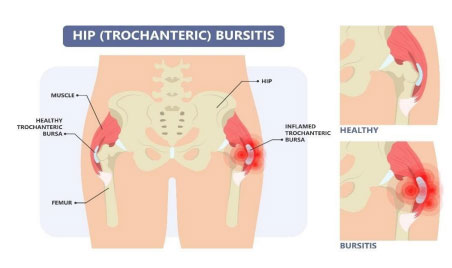Do you sit for extended periods of time so much that your groin feels stiff when you stand up? Are you a runner, a bicyclist, or a swimmer? Do you have a burning sensation in the upper front portion of your hip? Are you having a tough time moving your hip or walking quickly? Are you having difficulty putting on your socks and shoes? Are you having knee pain? If you answered yes to any of these questions, then you may have tendonitis and tendinosis of the hip. Read the details below for more information.
Causes
● Tendonitis of the hip has multiple names: trochanteric bursitis and hip flexor tendonitis.
● Tendonitis is a painful burning sensation caused by the inflammation or irritation of the tendon on the hip.
o A tendon is a thick fiber that connects the muscles to bone.
o When tendons become inflamed, patients may feel pain, tenderness, burning, and swelling near the affected area.
o The iliopsoas muscle is responsible for helping the hips bend forward by attaching to the upper thigh by a tendon.
o When the muscle becomes overused, the tendon can become inflamed or irritated causing hip tendonitis.
● Tendinosis is the degeneration of the tendon’s collagen in response to chronic overuse.
Symptoms
Symptoms may include
● Gradual frontal hip pain at the site of the tendon attachment,
● Burning sensations,
● Decreased hip mobility and strength,
● Difficulty standing upright after sitting for prolonged periods of time,
● Difficulty putting on your shoes and socks,
● Difficulty walking quickly,
● Frontal knee pain related to tight iliopsoas muscle.
Treatment
● If you experience any of these symptoms, please consult with your primary physician or general practitioner for a physical assessment to rule out other probable causes of hip pain.
● Surgery is rarely required for hip tendonitis.
● Rest, Ice, Compression, Elevation of the affected hip may help alleviate the condition.
● NSAIDs can reduce inflammation.
● Physical therapy for stretching and massaging the muscles and tendons will improve the condition.
Unfortunately, if tendinitis continues without any form of treatment, tendinosis will be the result.
Diagnostics
● X-ray to assess bone structure
● Magnetic resonance imaging (MRI) to assess possible soft tissue damage (ligaments and tendons)
● Bone scan to assess for bone diseases (e.g., cancer, fractures, osteomyelitis, avascular necrosis)

References
Bass E. (2012). Tendinopathy: why the difference between tendinitis and tendinosis matters. International journal of therapeutic massage & bodywork, 5(1), 14–17. https://doi.org/10.3822/ijtmb.v5i1.153
Beaumont. (2020). Hip Tendonitis. https://www.beaumont.org/conditions/hip-tendonitis Garry, J.P. (2019). Iliopsoas Tendinitis. https://emedicine.medscape.com/article/90993-overview
Rumruay. (2020). Hip (Trochanteric) Bursitis. [Illustration]. https://www.shutterstock.com/image-vector/hip-pain-knee-heel-cuff-bone-1866303562
